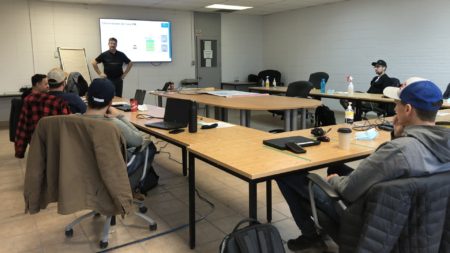Development and Training at the Heart of Our Operations

To date, 29 specific trainings and eight hands-on sessions have been offered.
Since the spring of 2020, Rio Tinto employees working for Asset Management have benefited from a training program tailored to promote and support skill development in their fields of expertise. Self-assessment and co-assessment activities have taken place in parallel to the training. These assessments were used to generate a bank of potential candidates and structure the training activities based on employee needs.
The work of developing the training was all done by in-house experts. The training sessions were designed to meet the needs of employees and enable them to acquire all the skills they need for their role in asset management.
“To date, 29 specific training sessions and 8 hands-on sessions have been held,” said Pierre Laprise, Asset Management Specialist and Project Manager. “The training program was launched in direct response to employee requests. Surveys demonstrated the need for this in-demand asset management training, and the high participation rate is just further proof of this. We would like to thank everyone who participated in the training whether by preparing documents or acting as trainers. Thanks to their commitment, we were able to create a personalised program that directly addresses our employees.”
An Overall Picture of Employee Needs
To develop a clear picture of training needs, a self-assessment and co-assessment activity was set up with the team at Institut Paul Héroult (IPH). “We drew on a skills matrix, designed in the Alcan days, to identify a series of 33 skills that mainly cover the basics of asset management,” said Mr. Laprise. “For every type of role, we identified the required skill level and training needs of employees. Since not all the employees are at the same level, the co-assessment activity, validated by direct managers, allowed us to define employee needs and add to the bank of potential candidates for each training session.”
Ten integration modules were first developed as video modules to allow new employees to quickly integrate key concepts. Then five web-based training sessions from the Development & Technology (D&T) group were added, along with nine specific training sessions. These training sessions, which may stretch to three days, are designed to meet specific needs. For example, one of these training sessions focuses on major shutdowns and another on work management.
Maxim Fortin, an engineer at Power Operations for the North sector, was in the first cohort of employees participating in the pilot project. The training sessions have been beneficial to him so far, allowing him to better integrate key theories and concepts and more fully understand the nature of his work.
He explained, “As an engineer, I have a role in overseeing and guiding the teams. The training sessions have helped me to understand certain concepts that are specific to Rio Tinto. The organisation’s commitment to ensuring that we all have the same foundations enables us to learn the best practices in detail and improve our efficiency.”
Among the trainers were Asset Management employees who had helped in developing and delivering the training sessions. For example, in brainstorming workshops that took place over several months, Pierre-Luc Dufour, a reliability engineer and trainer, helped design a training module on measuring the condition of assets.
“As a reliability specialist,” he explained, “our role is to coach and to share best practices; I was able to do just that through the training sessions that were offered. We highlighted the best practices in each sector and transformed them into accessible, clear educational material with real applications. The training sessions helped to strengthen employees’ skillsets and standardise practices. As a result, our employees have the right foundations and can prioritise efforts and investments effectively. We had positive feedback from employees who are willing to apply new knowledge. Ultimately, we can take a preventive approach and, by sharing knowledge, strengthen employees’ skills and contribute to the safety and reliability of sites.”
A Priority for Technical Services
Just before the end of the year, the Technical Services mutualised team also completed the self-assessment and most of the co-assessments for each of its employees. The next step will be to create individual development plans and offer continuous training tailored to employees and all sectors of activity. Alexandre Perron, General Manager, Technical Services, is committed to making this a priority.
He explained, “It is essential to know your team, to recognise its strengths and shortcomings, so that you can provide the tools to help our people grow, improve and stay motivated. The development plans will help us ensure that we have a strong and energised team that can handle the challenges that lie ahead.”



